

Studies of ROV concepts 2025 - Part B






1 - Control and Real-Time Monitoring of Autonomous Underwater
Vehicle Through Underwater Wireless Optical Communication

Authors: Dongwook Jung, Rouchen Zhang, Hyunjoon
Cho, Daehyeong Ji, Seunghyen Kim, and
Hyeungsik Choi
This paper introduces a new control structure using
underwater wireless optical communication (UWOC) for
autonomous underwater vehicle (AUV) motion control
in underwater missions. The UWOC system transfers
control inputs for the AUV's attitude from outside the
water, while orientation data and visual images are sent
to the control station outside the water. The system uses
a return-to-zero modulation scheme for faster, longer-
range data transfer. The hovering control performance
of the AUV with the UWOC system was experimentally
evaluated
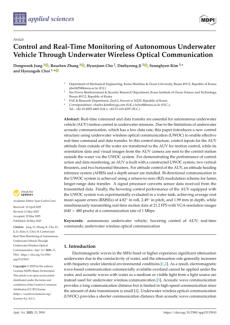



2 - Design and Performance Verification of A-HFM Signals for
Simultaneous Frame Detection, Cell ID Assignment, and Doppler
Estimation in AUVs Using Multiple Surface Buoys.
Authors: Yung-Jie Chen, Yu-Han Lin, Guo-Liang Shih, Chi-
Wai Chow, and Chien-Hung Yeh
This work proposes a wide field-of-view (FOV) air-to-water
OCC system using CUDA Deep-Neural-Network Long-
Short-Term-Memory (CuDNNLSTM). The system can
support a transmission rate of 7.2 kbit/s through a still
water surface and 6.6 kbit/s through a wavy water
surface, satisfying the hard-decision forward error
correction (HD-FEC) bit-error-rate (BER).
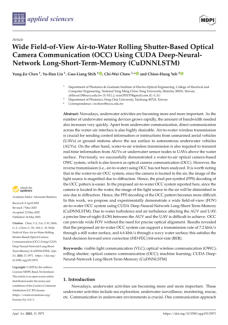



3 - Model-Based AUV Path Planning Using Curriculum Learning and
Deep Reinforcement Learning on a Simplified Electronic
Navigation Chart
Authors: Lukasz Marchel, Rafał Kot, Piotr Szymak, and
Paweł Piskur
This paper evaluates reinforcement learning (RL)-based
methods for autonomous underwater vehicles (AUVs)
trajectory planning. It incorporates a full motion model
and proposes a reward function to elicit desired
behaviors. The models are trained on simplified ENC maps
and compared against five classical methods. The
proposed solution enables efficient, collision-free route
planning.
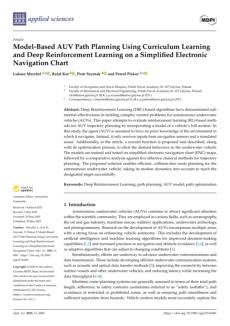



4 - Enhanced Real-Time Simulation of ROV Attitude and Trajectory
Under Ocean Current and Wake Disturbances
Authors: Yujing Zhao, Shipeng Xu, Xiaoben Zheng, Lisha
Luo, Boyan Xu, and Chunru Xiong
This study addresses issues in existing simulation systems
for remotely operated underwater vehicles (ROVs) by
developing a three-dimensional path simulation system
for ocean inspection robots. The system optimizes the
drag matrix by decomposing sea currents and simulating
relative velocity in each direction. The system improves
trajectory evolution stability and consistency, verifies
control algorithm applicability, and provides reliable data
support for ROV design and optimization. It also lays a
solid foundation for developing intelligent underwater
robots using IoT technology.




5 - Evaluation of the Nusantara 3 Remotely Operated Vehicle (N3-
ROV): Special Report on Performance and Stability in Various
Water Conditions
Authors: Xavercius Cezar Pratama, Indra Jaya,
Muhammad Iqbal
This study aimed to test the performance of the N3-ROV,
a Remotely Operated Underwater Vehicle (ROV), in two
different environments: a pool environment and a field
environment. The N3-ROV had dimensions of 61x65x34
cm, 13 kg, and 128.4 kg.m/s² buoyancy. Performance
tests showed that the N3-ROV had a straight movement
in the pool environment with a 0° error, but had higher
delay and error in the turning motion in the pool
environment.
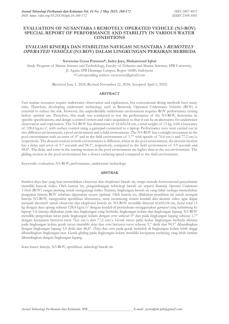



6 - A lightweight YOLO network using temporal features for high-
resolution sonar segmentation
Authors: Sen Gao, Wei Guo, Gaofei Xu, Ben Liu, Yu Sun,
and Bo Yuan
A novel YOLO-based segmentation framework addresses
the speed-accuracy trade-off in sonar image segmentation
for autonomous underwater vehicles (AUVs). The
framework uses a lightweight backbone network and
bypass BiLSTM network for temporal feature learning,
reducing processing latency and maintaining competitive
segmentation accuracy..
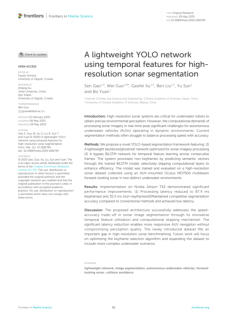



7 - Three-Phase High Power Underwater Capacitive Wireless Power
Transfer System for Autonomous Underwater Vehicles
Authors: Lei Yang, Liye Tian, Xinze Chen, Zhixue Bu,
Dengrui Xing, Aimin Zhang, and Xiangqian
Tong
The paper presents a 1000 W high-frequency three-phase
underwater capacitive wireless power transfer system for
autonomous underwater vehicles (AUVs). The system's
columnar structure and curved coupling coupler
enhance mutual capacitance and power transfer capacity,
reducing installation space and enhancing wireless power
transfer capacity.
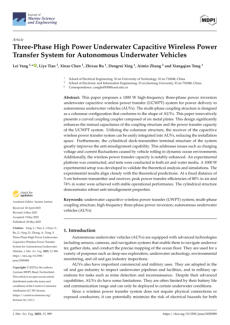



8 - Adaptive Event-Triggered Predictive Control for Agile Motion of
Underwater Vehicles
Authors: Bo Wang, Junchao Peng, Jing Zhou, and
Liming Zhao
This paper explores the design and agile motion control
of autonomous underwater vehicles (AUVs) in subsea
environments. It uses Sequential Quadratic Programming
(SQP) and Computational Fluid Dynamics (CFD) software
to solve propeller arrangement optimization. The AET-
NMPC algorithm significantly enhances response
capability and control accuracy, reducing trajectory
tracking error to 4.89%. This research provides insights for
sophisticated underwater operations in challenging
environments.
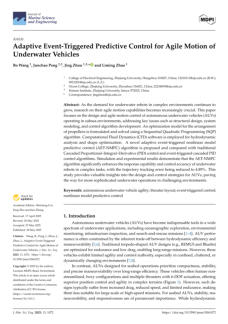



9 - Energy-Optimized Path Planning and Tracking Control Method
for AUV Based on SOC State Estimation
Authors: Guangyi Yang, Zhenning Xu, Feng Wang, and
Xiaoyu Zhang
This paper proposes a path planning and trajectory
tracking control framework for autonomous underwater
vehicles (AUVs) combined with battery state of charge
optimization. The framework uses the Grasshopper
Optimization Algorithm (GOA) and the Artificial Potential
Field Algorithm (APF) to achieve global path planning
and local path optimization while minimizing energy
consumption. The model predictive control (MPC)
method ensures accurate tracking and dynamic
management of SOC states. Simulation results show the
framework outperforms traditional methods.
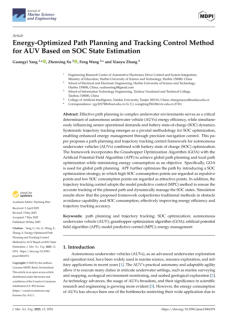


10 - Underwater SLAM Meets Deep Learning: Challenges, Multi-
Sensor Integration, and Future Directions
Authors: Mohamed Heshmat, Lyes Saad Saoud, Muayad
Abujabal, Atif Sultan, Mahmoud Elmezain,
Lakmal Seneviratne, and Irfan Hussain
This survey analyzes the latest developments in deep
learning-enhanced SLAM for underwater applications,
categorizing approaches based on methodologies, sensor
dependencies, and integration with deep learning
models. It highlights the benefits and limitations of existing
techniques, highlights key innovations, and unresolved
challenges. The survey introduces a novel classification
framework for underwater SLAM based on its integration
with underwater wireless sensor networks (UWSNs),
enhancing localization, mapping, and real-time data
sharing among AUVs. The survey identifies gaps in
current research and suggests future directions for
developing robust underwater SLAM solutions.
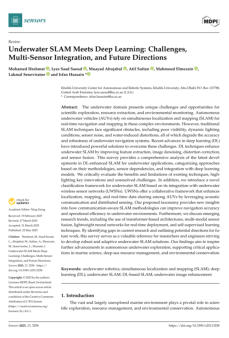



11 - Towards a Digital Twin for Open-Frame Underwater Vehicles
Using Evolutionary Algorithms
Authors: Félix Orjales, Julián Rodríguez-Cortegoso,
Enrique Fernández-Pérez, Alejandro Romero,
and Vicente Diaz-Casas
This paper proposes a comprehensive methodology for
obtaining hydrodynamic coefficients of underwater
vehicles, combining empirical measurements and
evolutionary algorithms. The methodology is applied to a
commercially available remotely operated vehicle,
BlueROV2, and analyzed for its adequacy, including
comparisons to the real vehicle.
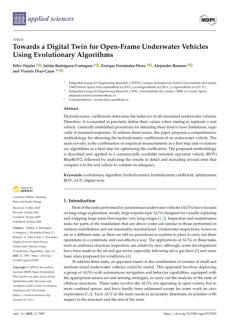



12 - Navigation Control and Signal Processing Methods for Multiple
Autonomous Unmanned Systems
Authors: Haoqian Huang, Bing Wang, and Yuan Yang
This paper proposes a novel approach for underactuated
autonomous underwater vehicles (AUVs) to improve
formation control. By integrating Decision-Making (DO)
with the formation controller, the system can handle
nonlinear dynamics and ensure system stability. The
approach addresses challenges such as assuming
diagonal mass and damping matrices, relying on position
measurements, and converge speed.
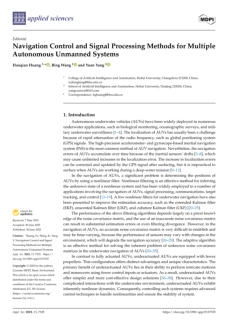



13 - Task Allocation and Path Planning Method for Unmanned
Underwater Vehicles
Authors: Feng Liu, Wei Xu, Zhiwen Feng, Changdong
Yu, Xiao Liang, Qun Su, and Jian Gao
This study proposes a task allocation and path planning
method for Unmanned Underwater Vehicles (UUVs) to
improve their autonomous navigation and adaptability in
complex marine environments. The method uses an
Improved Grey Wolf Algorithm (IGWA) and a Circle
chaotic mapping strategy to optimize task allocation and
search efficiency. The GR-RRT* algorithm is employed for
path planning, ensuring obstacle avoidance and reducing
redundant sampling. Experimental results show significant
advantages in task completion rate and path optimization
efficiency.
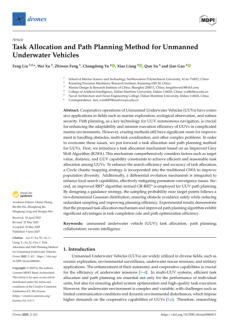



14 - AUV Trajectory Planning for Optimized Sensor Data Collection
in Internet of Underwater Things
Authors: Talal S. Almuzaini, and Andrey V. Savkin
This paper presents a Value of Information (VoI)-based
trajectory planning framework for a single Autonomous
Underwater Vehicle (AUV) and an Unmanned Surface
Vehicle (USV) to collect data from multiple Cluster Heads
in an uneven seafloor. The approach uses a forward
Dynamic Programming algorithm to optimize the AUV's
trajectory and USV's start and end positions, maximizing
residual VoI. Simulation results show the strategy
outperforms conventional baselines for effective data
collection in challenging underwater environments.
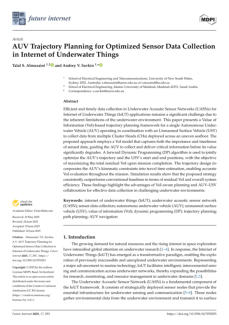



15 - Hydrodynamic Calculation and Analysis of a Complex-Shaped
ROV Moving near the Wall Based on CFDs
Authors: Mengjie Jiang, Chaohe Chen, Zhijia Suo and
Yingkai Dong
A study using computational fluid dynamics (CFDs)
analyzes the hydrodynamic characteristics of remotely
operated vehicles (ROVs) near walls, considering factors
like structural asymmetry, speed, and distance. Results
show that wall influence on hydrodynamic forces is
significant, with pressure differential resistance being the
dominant factor affecting performance. This provides
insights into calculating hydrodynamic coefficients and
modeling complex shapes operating near walls.
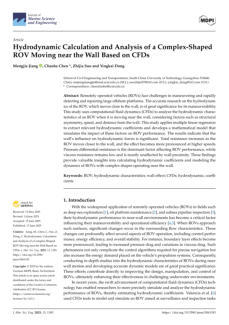



16 - Better interaction experience: human-machine interface for soft
robotic systems
Authors: Zeyu Gao, Zhiyuan Liao, Chunquan Li
Soft robots are emerging as a key robotics technology
due to their soft materials and unique drive methods.
They adapt to unstructured environments and interact
with humans safely, opening new directions in robotics
development. Sensor performance plays a crucial role in
human-machine interface (HMI), and new materials and
technologies refine HMI, enhancing soft robot systems'
possibilities.
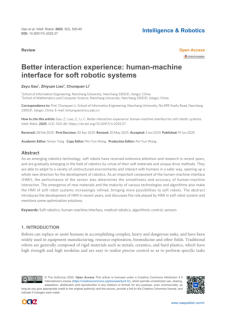



17 - Hierarchical Adaptive Fixed-Time Formation Control for Multiple
Underactuated Autonomous Underwater Vehicles Under
Uncertain Disturbances and Input Saturation
Authors: Jiacheng Chang, Lanyong Zhang, Yifan Tan,
Xue Fu, and Hongjun Yu
This paper proposes a novel hierarchical framework for
adaptive fixed-time formation control for multiple
autonomous underwater vehicles (AUVs). The framework
divides formation requirements and individual control
challenges into two layers: Collision-free Formation
Trajectories Generation (CFTG) and Adaptive Trajec-tories
Tracking (ATT). The CFTG layer uses a consensus-based
controller, an improved artificial potential field method,
and an auxiliary compensation system to meet complex
formation tasks. Simulations demonstrate the effectiveness
and performance of the proposed method.
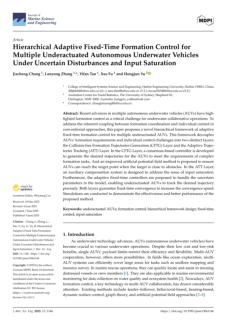



18 - ROVs Utilized in Communication and Remote Control
Integration Technologies for Smart Ocean Aquaculture
Monitoring Systems
Authors: Yen-Hsiang Liao, Chao-Feng Shih, Jia-Jhen Wu,
Yu-Xiang Wu, Chun-Hsiang Yang, and Chung-
Cheng Chang
This study presents an intelligent aquatic farming
surveillance system that integrates remotely operated
vehicles, sensors, and real-time data transmission. It uses a
mobile communication architecture with buoy relay
stations for distributed edge computing, supports future
upgrades to Beyond 5G and satellite networks, features a
multi-terminal control system for monitoring anytime,
anywhere, and is cost-effective. The system has
successfully processed 324,800 data transmission events,
demonstrating excellent performance in real-world
production environments. It reduces operating costs and
improves aquaculture efficiency.
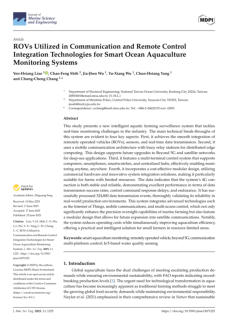



19 - Energy-Optimized Path Planning for Fully Actuated AUVs in
Complex 3D Environments
Authors: Shuo Liu, Zhengfei Wang, Tao Wang, Shanmin
Zhou, Yu Zhang, Pengji Jin, and Guanjun Yang
This paper presents an energy-optimized path planning
approach for fully actuated autonomous underwater
vehicles (AUVs) in three-dimensional ocean environments.
It uses real terrain data and environmental models to
develop a mathematical model of the AUV's total energy
consumption. The proposed algorithm combines EOPSO
and QP to identify the optimal path and surge speed,
demonstrating superior robustness and optimized energy
consumption.
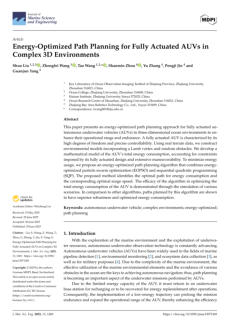



20 - Enhanced AUV Autonomy Through Fused Energy-Optimized
Path Planning and Deep Reinforcement Learning for Integrated
Navigation and Dynamic Obstacle Detection
Authors: Kaijie Zhang, Yuchen Ye, Kaihao Chen, Zao Li,
and Kangshun
This paper introduces a hybrid framework that combines
a Multithreaded Energy-Optimized Batch Informed Trees
(MEO-BIT*) algorithm with Deep Q-Networks (DQN) to
improve autonomous underwater vehicles (AUVs) in
dynamic environments. The MEO-BIT* component
provides efficient global path planning, while the DQN
component facilitates dynamic obstacle detection and
adaptive local navigation. Experimental validation in
asimulated Achao waterway (Chile) demonstrated the
system's superiority, achieving a 46% reduction in collision
rates, 15.7% improvement in path smoothness, and 78.9%
faster execution time compared to conventional
methods..
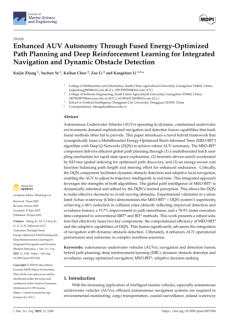



21 - Pectoral Fin-Assisted Braking and Agile Turning: A Biomimetic
Approach to Improve Underwater Robot Maneuverability
Authors: Qu He, Yunpeng Zhu, Weikun Li, Weicheng
Cui, and Dixia Fan
The study investigates the integration of biomimetic
pectoral fins into SpineWave robotic fins, enhancing
maneuverability, stability, and braking efficiency in
underwater robotics. The 1-DOF pectoral fin mechanism
reduces stopping distance by 50%, enhancing agility and
control, and laying the groundwork for adaptive fin
designs and real-time control strategies.
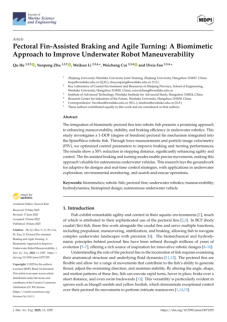



22 - Multi-Information-Assisted Bistatic Active Sonar Target Tracking
for Autonomous Underwater Vehicles in Shallow Water
Authors: Zhanpeng Bao, Yonglin Zhang, Yupeng Tai, Jun
Wang, Haibin Wang, Chao Li, Chenghao Hu,
and Peng Zhang
This paper proposes a multi-information-assisted target
tracking algorithm for bistatic active sonar, leveraging
spatial and temporal echo signal structures to improve
underwater surveillance for autonomous underwater
vehicles (AUVs). The algorithm integrates target position,
echo amplitude, and Doppler information during AUV
movement, improving association probability
computation efficiency. The algorithm shows a 23.95%
performance improvement over traditional probabilistic
data association, enhancing tracking autonomy and
advancing AUVs' capability in ocean engineering
applications.
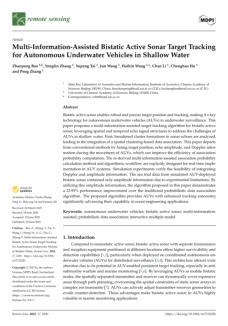


Click on the
octopus to return to
the top of the page











